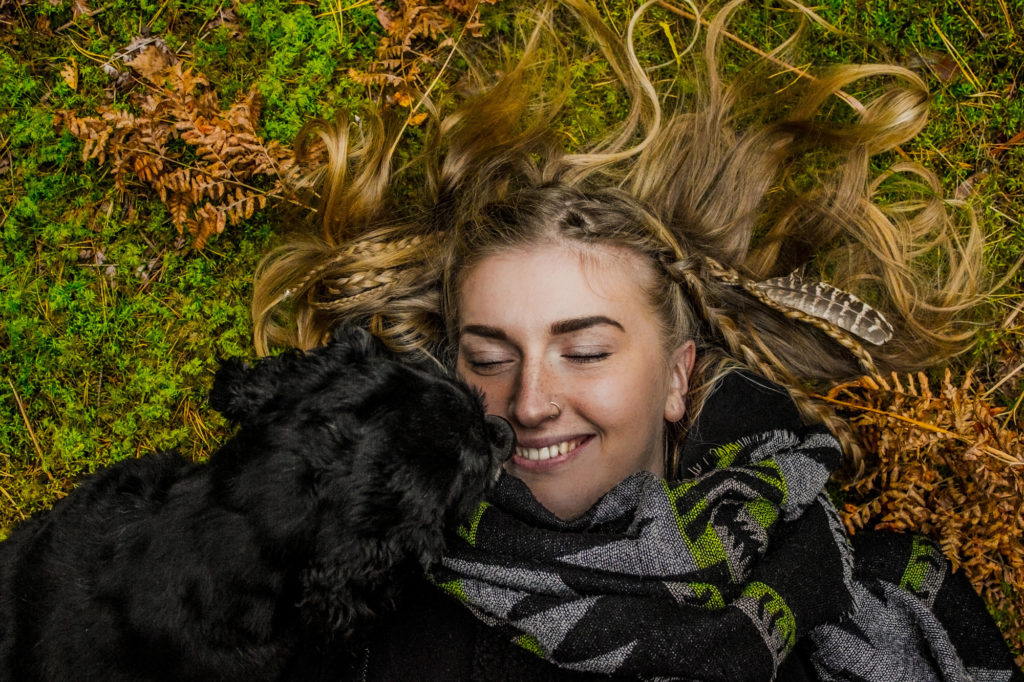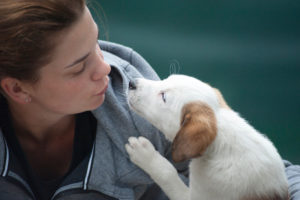 When you train a dog to detect anxiety, it can make a huge difference in your life. Your anxiety may not manifest as a full on panic attack, but it can still be extremely hard to deal with.
When you train a dog to detect anxiety, it can make a huge difference in your life. Your anxiety may not manifest as a full on panic attack, but it can still be extremely hard to deal with.
Well, and there’s that part where the anxiety can turn into a panic attack if you don’t get a handle on it. Beyond that though, anxiety can keep you from living your life to the fullest, especially when it feels unpredictable.
You can make your anxiety more predictable though! One of the things you can do to help is to train a dog to detect anxiety.
This is something that I train service dogs to do as a task for people with anxiety. (See my article Do You Qualify for a Service Dog?) It counts as a task if, when the dog lets you know that you’re having anxiety, you or the dog can do something to help make the anxiety feel better.
However, your dog doesn’t have to be a fully trained service dog to just do this for you at home. Training your dog to detect anxiety can help you keep a handle on things in day to day life.
What’s really nice is, you can train a dog to detect anxiety, even if your dog is a 10-year-old mutt from the shelter. Most dogs can learn how to do this with patience and persistence. If you think it might help you at home, why not try?
If you’re having anxiety in public that keeps you from being able to function normally, you might think about training a service dog so that you can have them help you with this when you are out in public. If this seems like a path that interests you, check out my articles on owner-training a service dog.
Why Train a Dog to Detect Anxiety
 When I begin to get anxious, I don’t usually realize it until I’m really feeling tense and sick to my stomach. It really helps me to have my dog, Luna, to help me remember to relax and take some steps to feel less anxious.
When I begin to get anxious, I don’t usually realize it until I’m really feeling tense and sick to my stomach. It really helps me to have my dog, Luna, to help me remember to relax and take some steps to feel less anxious.
Training your dog to detect anxiety can remind you to do things to help your anxiety, like:
- Take fast-acting medication that helps you before the anxiety gets too bad.
- Do some meditation.
- Take deep breaths and slow your breathing.
- To ground yourself.
- Repeat a mantra.
- Remove yourself from the situation causing the anxiety.
Or, you can also train your dog to do some things to help with your anxiety, like:
- Bring you your medication
- Deep pressure therapy
- Turn on the lights in a room (if, say, you are having anxiety in your room at night)
- Grounding you by licking your face or pressing their nose into your hand.
- Lead you away from an anxiety-inducing situation
How to Train a Dog to Detect Anxiety
 So, how do you actually train a dog to detect anxiety? Here are the steps.
So, how do you actually train a dog to detect anxiety? Here are the steps.
- Write down the symptoms you have when you begin to feel anxious. For example, when I am anxious, I feel tense in my shoulders and sick to my stomach.
- Identify which symptoms your dog could learn to notice. A dog can usually be taught to sense symptoms that can be seen, heard or smelled, like these:
- Hyperventilating
- Fast heartbeat
- Tense muscles
- Trembling/muscle twitching
- Nervous tics (pulling out your hair, nervously running your fingers over something over and over, etc)
- Teach your dog the action you want them to do to alert you. Most people like quiet alerts, like the dog scratching at your leg or jabbing you with its nose. Teaching this type of alert can be done by teaching targeting.
- Nose targets: you rub a piece of smelly stuff on the palm of your hand and hold it out. When the dog touches your palm with its nose, you reward.
- Foot targets: you put a smelly treat under a plastic lid and when the dog scratches at it, you reward. When the dog learns to do it without a treat underneath, you can transfer the lid to your leg, then remove the lid from your leg so they target just your leg with their paw.
- Give the targeting a name (e.g. “Alert!”) and teach the dog to do it with other body parts and in different situations without the lid or the smelly treat involved.
- Now, recreate your symptoms that you wrote down (so say, hyperventilate for the dog) and then say the name of the targeting behavior. Reward the dog for doing the targeting.
- When you can tell you are actually getting anxious, ask for “Alert!” and reward the dog for doing it.
- Over time, begin to remove the verbal word (“Alert!”) and start to ask the dog to do the targeting just when you recreate your symptoms.
- Your dog will begin to notice when you are getting anxious and do the alert. Over time, if they are perceptive, they will start to alert you to the very earliest signs of your anxiety.
Conclusion
You can definitely train a dog to detect anxiety on your own.
You don’t need a special dog to do it and you don’t need to be particularly good at training to do it.
If you keep trying, your dog can alert you when you’re starting to get anxious. It can be frustrating to train this at times, but keep working at it. You’ll get it. The benefits are worth the work. Even if you aren’t ready for a service dog, you can still get help from the dog you do have at home.
Think your dog might make a good service dog? Get a free temperament test so you can see!
